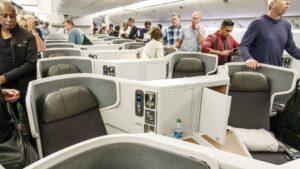The Changing Landscape of Airline Seating: Why Premium Cabins Are the Future
The world of air travel is evolving rapidly, especially when it comes to how passengers prioritize comfort and space during flights. Once upon a time, low-cost seats dominated the conversation in aviation. However, since the pandemic, a significant shift has taken place, and today’s travelers are increasingly willing to pay a premium for a more spacious and comfortable experience at the front of the cabin. At Extreme Investor Network, we dive deeper into how airlines are navigating this changing paradigm and what it means for both passengers and the airline industry overall.
Premium Seating in High Demand
The landscape of airline travel has transformed dramatically. Many passengers have discovered their willingness to invest in premium seating, indicating a striking change in consumer behavior. The demand for business and first-class seats is surging, evidenced by the increasing competition among travelers to secure those coveted upgrade spots. With frequent flyer programs swelling in membership, the chance to score a free upgrade is becoming more elusive.
The situation will only intensify as we approach the year-end holiday travel period, when airlines expect record-breaking passenger numbers. According to industry forecasts, U.S. airlines plan to ramp up capacity by 1% in the first quarter of 2025 compared to the previous year. This trend signals not only a robust recovery but a shift toward more premium offerings that align with consumer expectations.
The Financial Impact of Loyalty Programs
Airlines have realized that their loyalty programs can significantly boost revenue, and they are adapting accordingly. In recent years, airlines have revised their elite status requirements, emphasizing spend over mere flying distance. This year, for instance, United Airlines is increasing the spending threshold for its elite status, while American Airlines has opted to keep its requirements unchanged for the coming year.
This strategic pivot reflects the industry’s efforts to strike a balance between loyalty rewards and the economic realities of running an airline. As airlines fine-tune their offerings, passengers must stay informed about any changes that may impact their traveling experience or status privileges.
A Shift from Giveaways to Value
An interesting trend is the shift from free upgrades to a model where travelers are increasingly opting to pay for premium service. Years ago, a mere 12% of Delta Air Lines’ domestic first-class seats were sold, but that figure has skyrocketed to around 75%. Delta’s president, Glen Hauenstein, has noted the transformation, stating that the value of premium seats is now at the forefront of the airline’s business strategy.
The trend is not limited to Delta. Airlines like JetBlue and Alaska Airlines are also pivoting to include more premium options. JetBlue is introducing a "junior Mint" class for their domestic flights, while Alaska Airlines is upgrading its fleet to feature premium seating in anticipation of a growing demand for international travel.
Embracing the Premium Experience
American Airlines is actively retrofitting some long-haul aircraft to incorporate more premium seating, echoing the broader industry trend. The airline has streamlined the upgrade process for passengers, making it easier to book a more opulent experience. As demand for premium cabin experiences continues to rise, airlines are tapping into newfound willingness among consumers to pay a premium for enhanced comfort and exclusive amenities, such as flatbed seats and private cabin spaces.
What Lies Ahead?
It’s clear that airlines are adapting to the new market demands informed by evolving consumer preferences. Budget carriers like Southwest Airlines are recognizing the shift in consumer mentality toward valuing comfort and premium offerings, even if that doesn’t entail introducing a first-class section.
CEO Bob Jordan has noted that younger travelers show a willingness to spend more on curated travel experiences while reducing expenditures in other areas. This understanding can guide airlines as they develop their sales strategies moving forward.
Conclusion
As we continue to monitor trends from the world of aviation at Extreme Investor Network, one thing is clear: the demand for premium seating is more than a fleeting trend—it’s a fundamental shift in how we think about air travel. Travelers want a tailored experience that matches their priorities of comfort and service. For airlines, navigating this new landscape presents both challenges and outstanding revenue opportunities.
Staying attuned to these developments can empower travelers with the knowledge to make informed choices while possibly enhancing their travel experiences in the future. Join us as we explore further how consumer preferences and economic factors will shape the airline industry going forward.
For more insights into the world of investing and business, keep visiting Extreme Investor Network!

